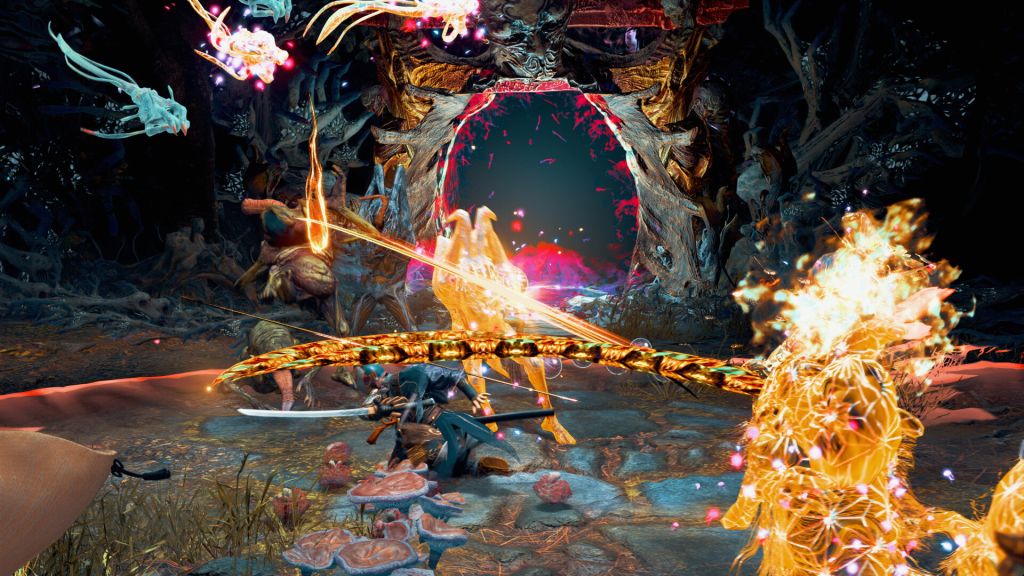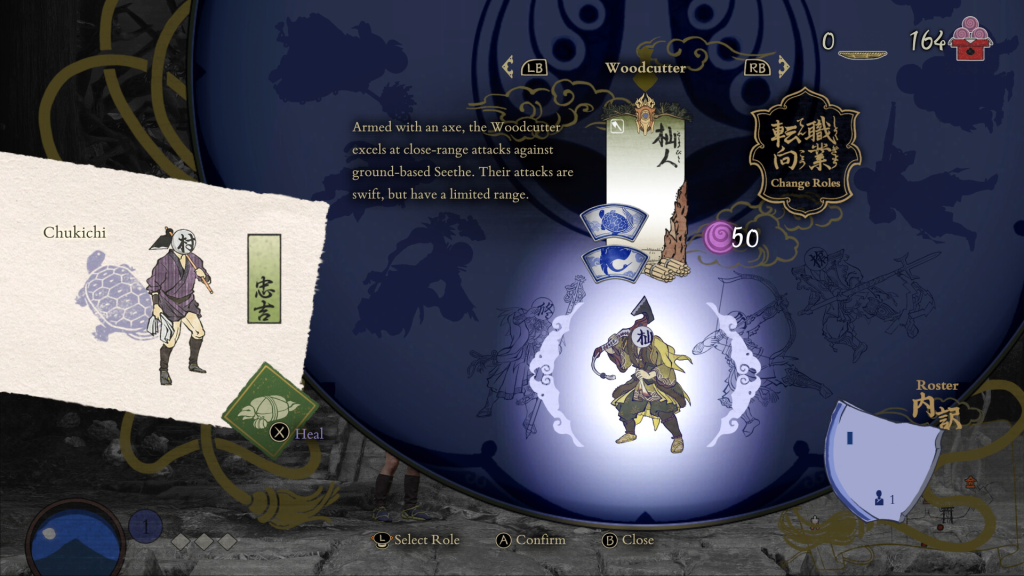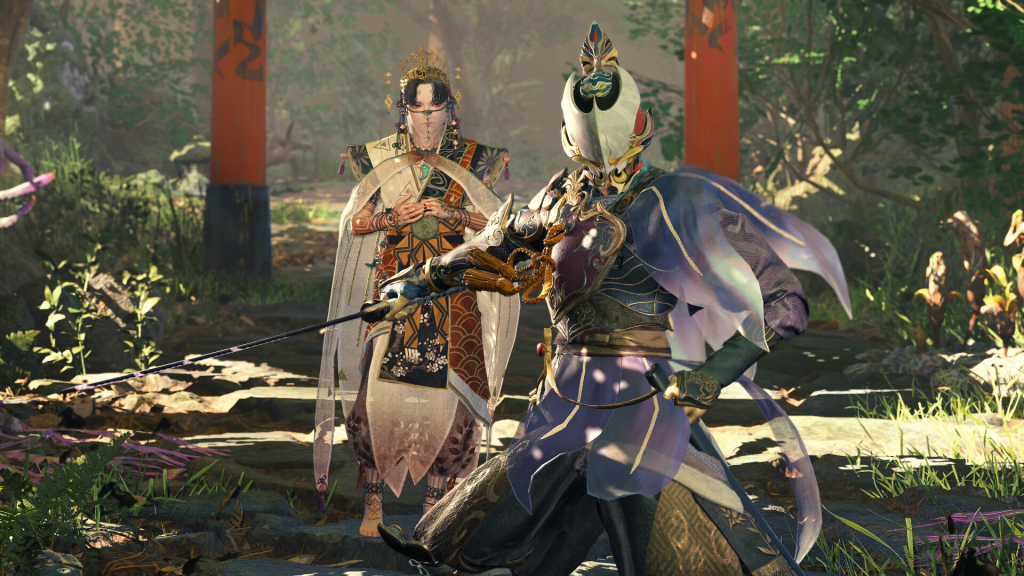A black mist pours through a scarlet torii gate, with fingers clamped firmly around its edges. Pale pink light emanates from a thousand lotus petals that dance beneath the feet of a priestess as a masked warrior moves in tandem, slicing through insect-like demons that pour forth. Dawn breaks and these creatures melt away into webs of red ichor. As the maiden dances, she purifies the land around her and brings calm to a now-cursed mountain. This is Kunitsu-Gami: Path of the Goddess, Capcom’s latest foray into an entirely new IP.
The narrative of Kunitsu-Gami is a simple, but effective, one. The Seethe, a malicious presence, escaped from its confinement on Mount Kafuku. The Maiden Yoshiro must press back against the defilement that has now corrupted the inhabitants of the village and destroyed the settlements throughout. The player does not assume the role of Yoshiro, but instead Soh, a summoned warrior that is capable of assisting the Maiden in her banishment of the Seethe. With sword in hand, Yoshiro and Soh work together as she dances to rid the world of this malicious presence, with you as her protector. The game is straightforward and uses the narrative as a means to get players right into the action, with its Japanese aesthetic and focus on folklore designed to create something that feels like a reasonable attempt at a new one-off IP for Capcom.
Kunitsu-Gami eases the player into its various systems. The game will guide you through its base building mechanic, which in truth is more or less the restoration of smaller shrines and areas that have been destroyed due to the pervasive presence of the Seethe. You cannot restore or rebuild any of these structures immediately and will instead need to assign a specific number of villagers to said reconstruction, with the passing of time dictated by completing missions. Restoring these areas will reward the player with Musubi, which can then be used to upgrade the masks you equip your units with. I ended up grinding away, setting my villagers to the task of rebuilding statues and buildings, before major encounters which allowed me to upgrade these masks to empower my units.

Masks more or less serve as a class system of sorts, with more becoming available as you progress the story. Villagers can be assigned roles before and during stages, depending on whether it is a generic tower-defense stage or a boss fight. There are more than a handful of different roles that can be obtained through the game, with each role a villager can assume based on the mask they have been assigned to wear. The first role players will unlock is the Woodcutter, which attacks enemies in its immediate vicinity as a melee class, with the second being the Archer. From there, you can unlock roles such as the Ascetic, which provide more supplementary skills such as creating barriers. There are other roles too, such as Ninja, which can play instrumental parts in specific stages, as each stage is more or less a puzzle players can solve through the use of these roles. I personally favored ranged roles such as the Archer, which gave me ranged support as I would tear through Seethe, attacking and blocking and micromanaging my units as Soh. Having a more active role in combat was honestly refreshing, and instead of just watching units fight I was more involved and more attentive.
At its heart, Kunitsu-Gami is a hybrid tower-defense and real-time strategy game. I would even go so far to say that it could even qualify to be called an action game, given that there are various combos you can perform to slice through and banish Seethe to varying effect. But at its heart, Kunitsu-Gami is about protecting a singular objective — that being the Maiden Yoshiro. Yoshiro, and Soh, are tasked with removing the “defilement” from Mount Kafuku, but this can only be done by escorting her to various Shinto shrines located throughout the mountain. Is it your duty as Soh to escort her through various stages, breaking through corrupted torii gates and banishing the Seethe that pour through. However, you’re not alone in this objective.

During the day, players can cleanse each stage of the defilement, freeing villagers from brightly colored, chitinous cocoons. These villagers can then be assigned roles through the use of the aforementioned mask system and then put into position before sun sets and the Seethe crawl out of the defiled torii gates. (You can also command units to reposition to attack and defend with a simple press of a button, which makes things less complicated to a degree.)Thankfully, you can change the role of your villagers during stages, which is sometimes necessary.
Kunitsu-Gami doesn’t always telegraph what enemies will be pouring out of these corrupted gates, so it’s often good to have a healthy mix of ranged, support, and melee units. But again, if you need to swap it up you can do so in the middle of combat for a price. This means that swapping out masks isn’t something you can infinitely do in the midst of battle. Swapping masks costs crystals, which can be earned during stages, but only in a finite amount. Boss encounters function similarly, except you are given the opportunity to prepare before a fight without a timer ticking down for you to banish the corruption and free villagers to aid you as Yoshiro dances towards the torii gates you need to purify.
But what is most striking about Kunitsu-Gami is its art style. The game is saturated with bright colors and kaleidoscope effects that accentuate each swing of Soh’s sword. Environments are full of strange, insect-like growths that blossom into flowers of a vibrant pink with the corrupted torii gates sealed with a mass of gray fingers that dig inward. There is a level of uncanniness there that lends itself well to the game, encapsulating the unknowable nature of the Seethe, or rather that they are not of our world. I generally do not like to draw comparisons between games, but a lot of the designs in Kunitsu-Gami reminded me of the insect-like nature of the shibito in Siren: Blood Curse, also known as Siren: New Translation.

I absolutely adored the designs of the Seethe, each more uncanny than the next as they ventured deeper and deeper into the unknowable. Notable yokai such as the Kamaitachi appear, but not in a way that I would expect something so significant in Japanese folklore to be represented. Instead of a weasel, or something resembling a weasel. The Seethe version that appeared in this game was a mess of wispy flesh with something comparable to a wasp stinger attached to its lower half. The art direction in the game is really just fantastic, and one of the best things about Kunitsu-Gami, which I found myself enjoying despite how sparse the narrative actually is.
What I can say for Kunitsu-Gami is that it feels like a game that could have existed on the PlayStation 2, and I mean that in the most positive way possible. It’s experimental and interesting, and I’m glad Capcom Development Studio 1 was able to make this game. The way it builds on the tower-defense genre and gives the player a more active role through the use of Soh as an avatar makes the game immediately more involved and interesting. I hope Kunitsu-Gami ends up garnering some kind of success so that it can show Capcom that these risks can be taken, even for AA titles, so we can see more of what its various development studios can create outside of established franchises.
Kunitsu-gami: Path of the Goddess will come out on July 19, 2024 for the PS4, PS5, Xbox Series X, Xbox One, and Windows PC.
Kunitsu-Gami: Path of the Goddess
Kunitsu-Gami is an invigorating take on the tower-defense genre, as it blends exciting action combat to make something truly unique.
Pros
- Inspired yokai designs and a gorgeous art style make Kunitsu-Gami a treat for the eyes.
- An interesting and unique take on the tower-defense genre that won't leave you bored.
- The music is limited, but beautiful.